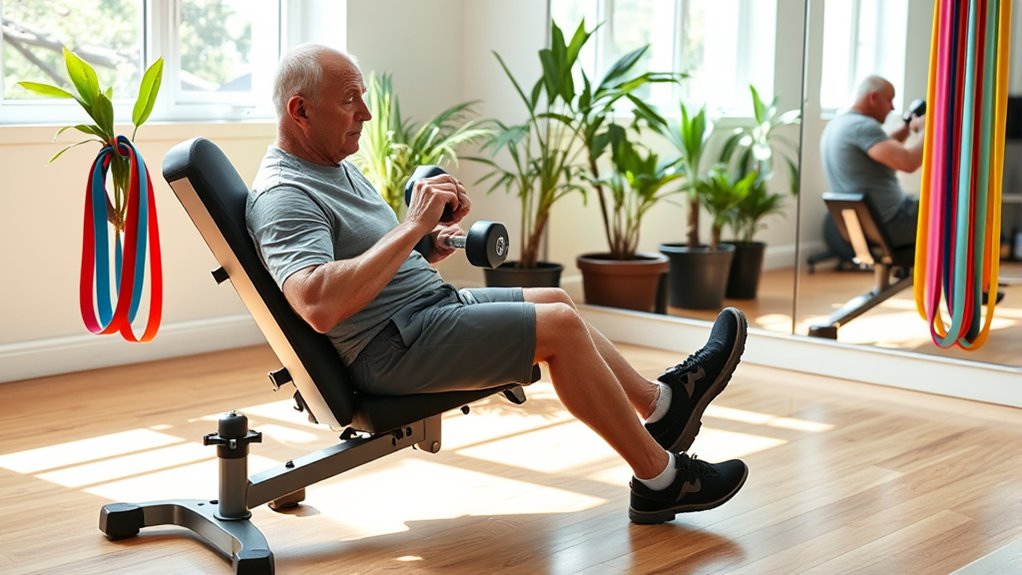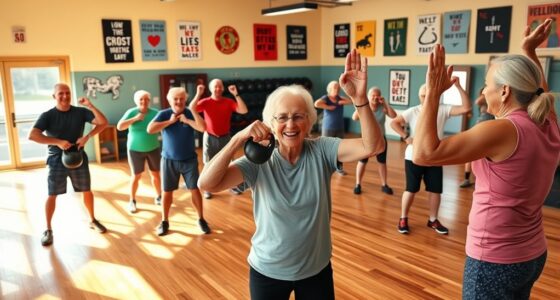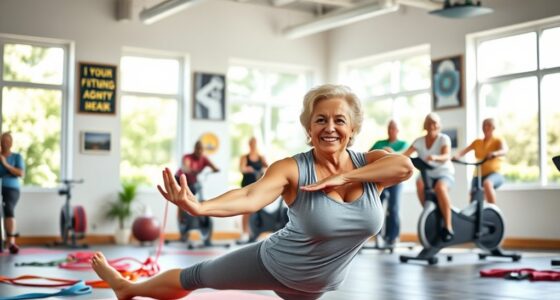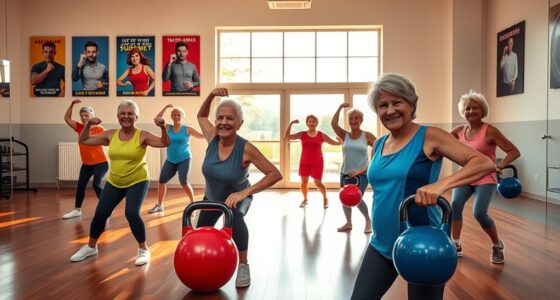Seated strength training is a fantastic way for you to build muscle while sitting down, making it safe and effective for seniors. It accommodates different fitness levels and helps combat age-related muscle decline. By incorporating exercises for your upper and lower body, and focusing on core stability, you’ll enhance strength and mobility. Plus, proper warm-up and cool-down routines can aid recovery. Stick around to discover essential tips and techniques to boost your fitness journey further.
Key Takeaways
- Seated strength training safely builds muscle in seniors, accommodating various fitness levels and reducing injury risks.
- Effective exercises include overhead presses, bicep curls, and mini squats, using light weights for accessibility.
- Warming up with dynamic stretches and breathing exercises enhances flexibility, mobility, and overall readiness for workouts.
- Core stability exercises, like “stir the pot,” improve posture, balance, and functional mobility, essential for preventing falls.
- Structuring workout sessions with sets, rest, and cool-downs promotes muscle repair and strength gains, ensuring effective training.
The Benefits of Seated Strength Training for Seniors
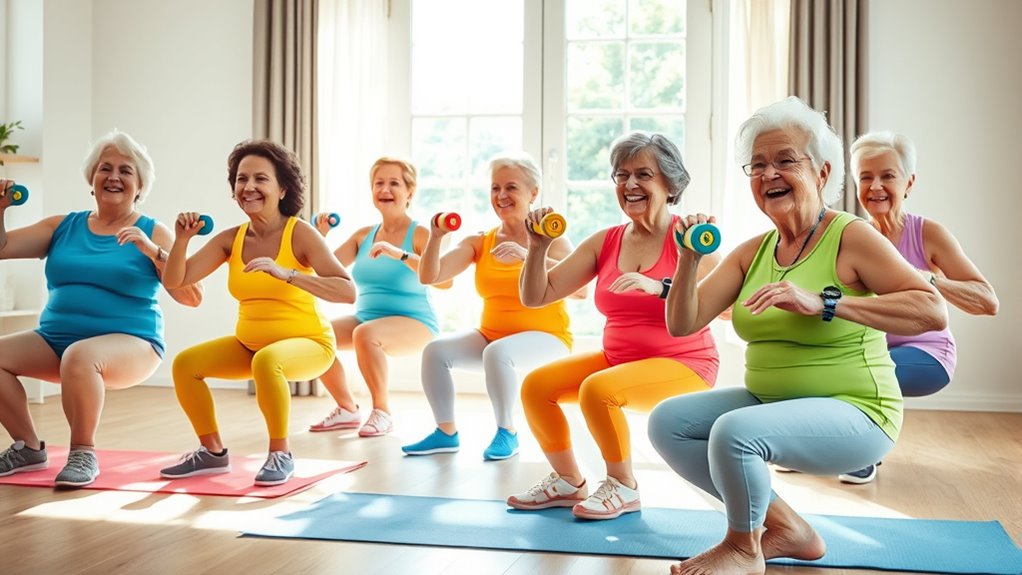
As you age, maintaining your strength becomes vital, and seated strength training offers a safe and effective way to do just that. This method allows you to build muscle safely, accommodating varying fitness levels while markedly reducing the risk of injury. As muscle mass typically decreases by 3 to 8% every decade, especially after 60, seated exercises play an important role in maintaining and improving your muscle strength. They also enhance bone density and overall health, combating age-related declines. Additionally, regular exercise can help alleviate stress and anxiety, fostering better emotional well-being for seniors facing end of life planning challenges. Engaging in activities that promote emotional needs is essential for mental well-being and happiness. Furthermore, regular strength training can also lead to improved financial stability as seniors may require less medical intervention for age-related health issues. This approach not only supports physical health but also helps in building resilience against life’s challenges, ensuring a more fulfilling quality of life. Studies show that hydration is crucial for maintaining optimal brain function, which can further enhance the benefits of seated strength training.
Essential Warm-Up Routines for Safe Workouts
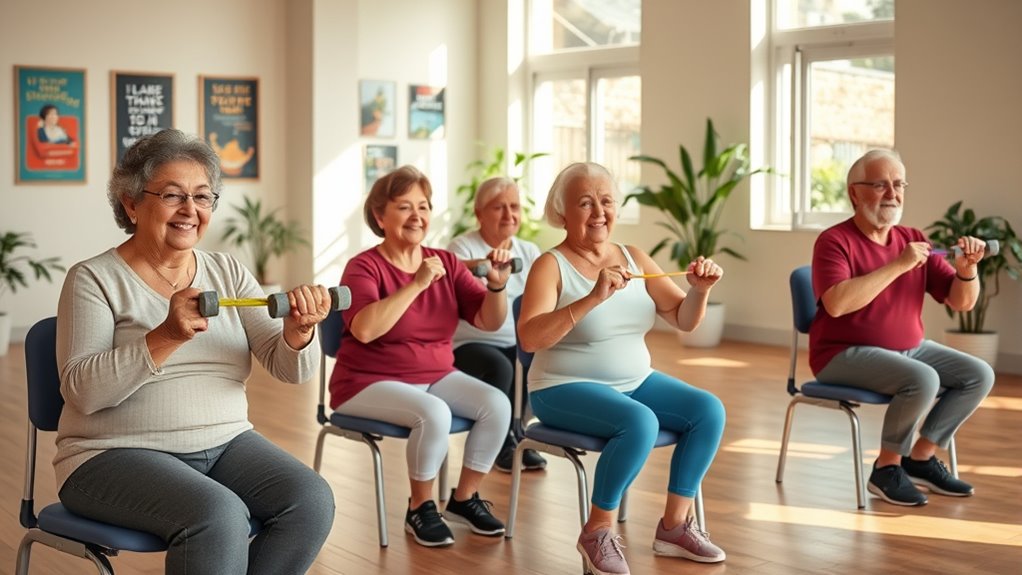
Warming up is essential for preparing your muscles and joints before seated strength training, helping to prevent injuries. You can incorporate dynamic stretching techniques and mobility exercises to enhance flexibility and blood flow. Consider using essential oils like eucalyptus or peppermint oil during your warm-up to promote easier breathing and enhance circulation. Additionally, it’s important to be aware of state tax implications that may affect your financial strategy in retirement, particularly if you plan on making IRA withdrawals to support your workouts. Engaging in regular physical activity can also help mitigate brain fog symptoms often experienced by seniors, ensuring a more effective workout. Adding breathing exercises won’t only activate your body but also guarantee you’re ready for an effective workout. Additionally, consider incorporating natural remedies that may help improve overall wellness during your training routine. To further support your workout preparation, include fresh orange juice in your diet for its natural energy-boosting properties.
Importance of Warming Up
Before diving into strength training, it’s important to warm up your body, as this essential step reduces the risk of injury and prepares your muscles for exercise.
Engaging in a proper warm-up routine is especially significant for seniors. Here are some effective activities to include:
- Heel touches to engage your core
- Marching in place to boost circulation
- Arm swings to loosen your shoulders
- Shoulder rolls for improved flexibility
- Deep breathing exercises to promote relaxation
A thorough warm-up session typically lasts about 5 to 10 minutes. Maintaining good air quality in your workout space can enhance your performance and overall well-being during your exercises. Incorporating air purifiers can help reduce allergens and improve indoor air quality, making your workout environment healthier. Regular physical activity can also lead to improved health outcomes in seniors, contributing to better mobility and overall fitness. Additionally, engaging in exercises that promote skin hydration can support overall wellness during your fitness journey.
Proper maintenance of your workout equipment ensures optimal performance and safety during your exercises.
Incorporating these movements into your routine helps increase blood flow and enhances joint mobility, ensuring your body is ready for the upcoming physical demands of seated strength training. Additionally, maintaining good air quality in your workout space can further enhance performance and overall well-being during your exercises.
Dynamic Stretching Techniques
Dynamic stretching techniques are essential for seniors looking to prepare their bodies for seated strength training. Incorporate movements like heel touches, marching in place, and arm swings to boost blood flow and warm up your muscles. Engaging in shoulder rolls and cross-body motions enhances flexibility and helps maintain your range of motion. Additionally, proper planning for strength training can help seniors avoid injuries and maximize their workout benefits. Don’t forget toe taps and deep breathing exercises, which activate your core and improve lung capacity. Including a variety of movements can enhance your overall flexibility and strength, similar to how crop rotation benefits soil health in farming. Furthermore, incorporating natural elements in your workout environment can promote a calming atmosphere that enhances focus and motivation.
These dynamic stretching techniques not only prime your body for exercise but also mentally prepare you for your workout, fostering a positive mindset. A structured warm-up routine considerably reduces the risk of injury by gradually increasing muscle temperature and elasticity, ensuring you’re ready for effective seated strength exercises. Additionally, understanding bank opening hours can help seniors plan their workouts around when they can access fitness resources or equipment. Furthermore, understanding budgeting for fitness can help seniors invest in the right equipment and classes to support their strength training journey.
Breathing and Mobility Exercises
As you prepare for seated strength training, incorporating breathing and mobility exercises into your warm-up routine is essential for enhancing performance and ensuring safety.
Breathing exercises increase your lung capacity and oxygen flow, crucial for endurance. Mobility exercises like shoulder rolls and neck stretches boost flexibility, reducing injury risk. Regularly practicing deep breathing techniques can also improve your overall well-being.
Here are some effective warm-up movements to include:
- Deep breathing: Engage in deep, calming breaths to promote relaxation.
- Seated marches: Lift each knee alternately to warm up your legs.
- Arm circles: Move your arms in small circles to increase shoulder mobility.
- Neck stretches: Gently tilt your head from side to side.
- Shoulder rolls: Roll your shoulders forward and backward to release tension.
Incorporating herbal teas into your routine can also promote relaxation and reduce stress, enhancing your overall workout experience.
These practices prepare your body for a safe and effective workout.
Upper Body Exercises to Enhance Strength
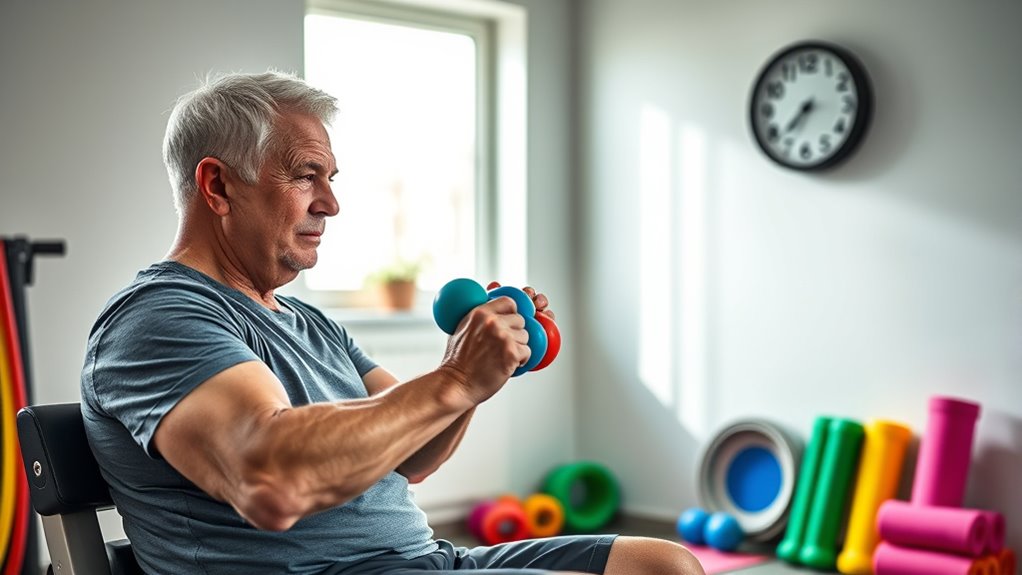
To enhance upper body strength, seated exercises provide a safe and effective way for seniors to engage their muscles without the risk of instability.
Incorporating movements like overhead presses and bicep curls allows you to target key muscle groups while ensuring stability. You can also try canoeing motions and elbow lifts to improve shoulder flexibility and arm strength, which are essential for daily activities.
Using light weights, such as water bottles or cans, makes these exercises accessible for everyone. Remember to engage your core during your workouts to maintain good posture and stability.
Regular practice of seated upper body exercises can lead to improved muscle mass and overall strength, effectively countering age-related decline.
Lower Body Strengthening Movements

While maintaining stability is essential for seniors, seated lower body strengthening movements offer a fantastic way to enhance leg strength and mobility.
Seated lower body exercises are vital for seniors to enhance strength and mobility while ensuring stability.
These exercises engage your glutes and hips while providing the support you need. Here are some effective movements to incorporate into your routine:
- Mini squats to strengthen your quads
- Leg lifts with a kick to boost hip strength
- Toes up movements to improve foot strength
- Heels up movements for better balance
- Seated marches to keep your legs active
Regularly practicing these lower body exercises can help combat age-related muscle loss, enabling you to maintain independence and perform daily activities with ease.
Core Stability Exercises for Improved Posture

Strong core stability is essential for maintaining good posture, especially as we age. Engaging in core stability exercises helps support your spine, reducing the risk of back pain and enhancing your overall strength.
Movements like the “stir the pot” not only improve balance and coordination but also play an important role in daily activities and fall prevention. By incorporating seated core exercises into your routine, you’ll increase muscle engagement in your midsection, promoting functional mobility.
This training can also positively impact your respiratory function, allowing for better oxygen intake. Regular practice of core stability exercises combats age-related declines in muscle mass and bone density, helping you maintain energy and independence as you grow older.
Structuring Your Seated Workout Sessions
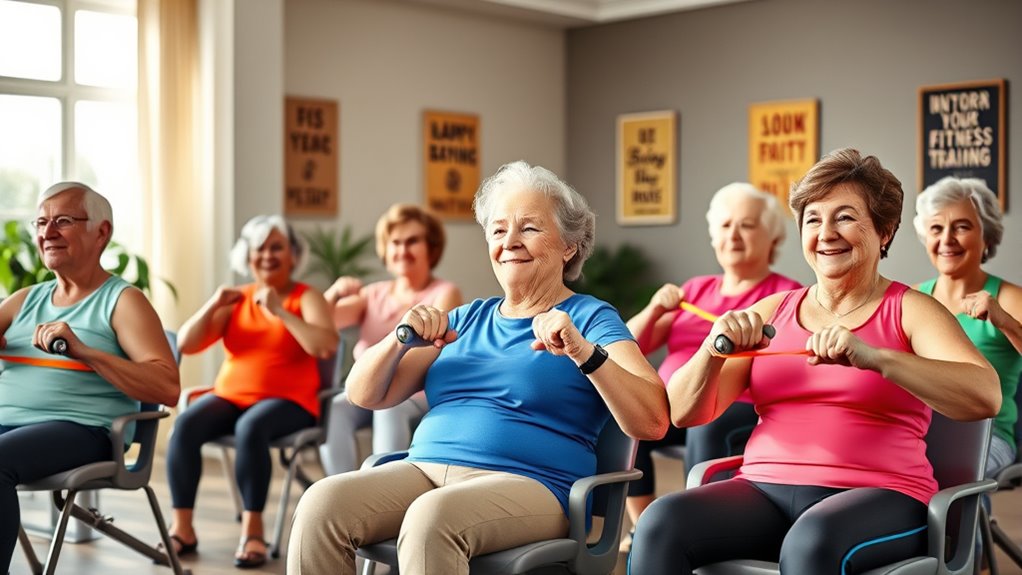
Creating an effective seated workout session is key to maximizing your strength training results as a senior. Start by structuring your sessions to include two sets of five exercises, each performed for 30 seconds, with a 20-second rest in between.
Remember to lean forward slightly during exercises to engage your core and improve stability.
Here are some tips to take into account:
- Incorporate both upper and lower body exercises.
- Alternate movements, like seated bicep curls and mini squats.
- Use weights or water bottles for added resistance.
- Always include a warm-up and cool down routine.
- Focus on maintaining proper posture throughout your workout.
This structure not only enhances muscle engagement but also promotes balance and stability, essential for combating age-related muscle loss.
Importance of Rest and Recovery
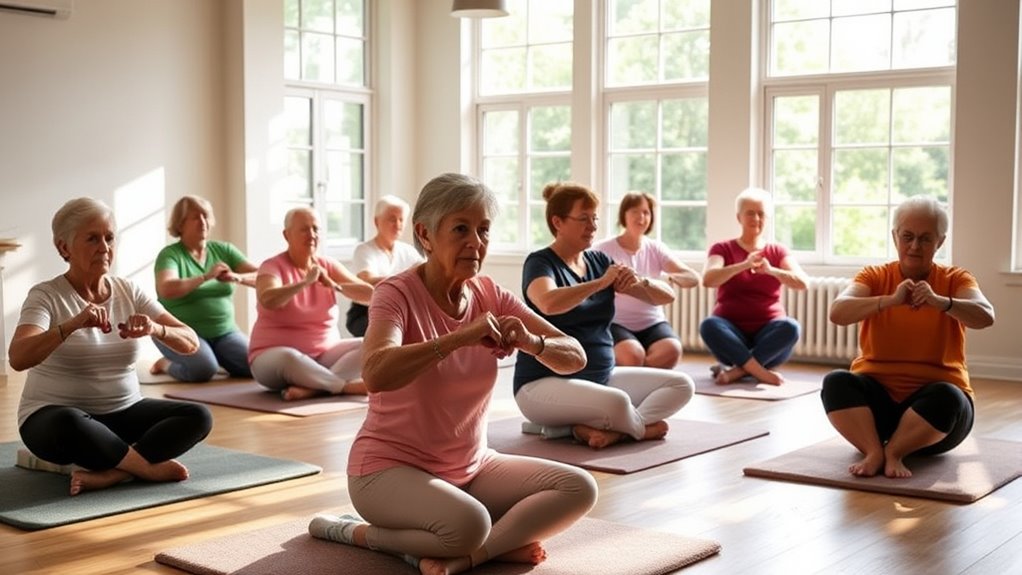
After structuring your seated workout sessions, it’s important to recognize the role of rest and recovery in your training routine.
Taking 40 to 45 seconds for rest between sets is essential for muscle repair and enhances your performance, especially as muscle mass declines with age. During these breaks, stay hydrated to support muscle function and overall health.
Incorporating gentle movements, like keeping your feet moving, can help promote blood circulation and prevent stiffness while your muscles recover.
Additionally, following your workouts with a cool-down routine and stretching alleviates muscle tension, reduces injury risks, and promotes flexibility.
Prioritizing rest and recovery will lead to improved strength gains and make your workouts more effective.
Tips for Staying Motivated in Your Fitness Journey
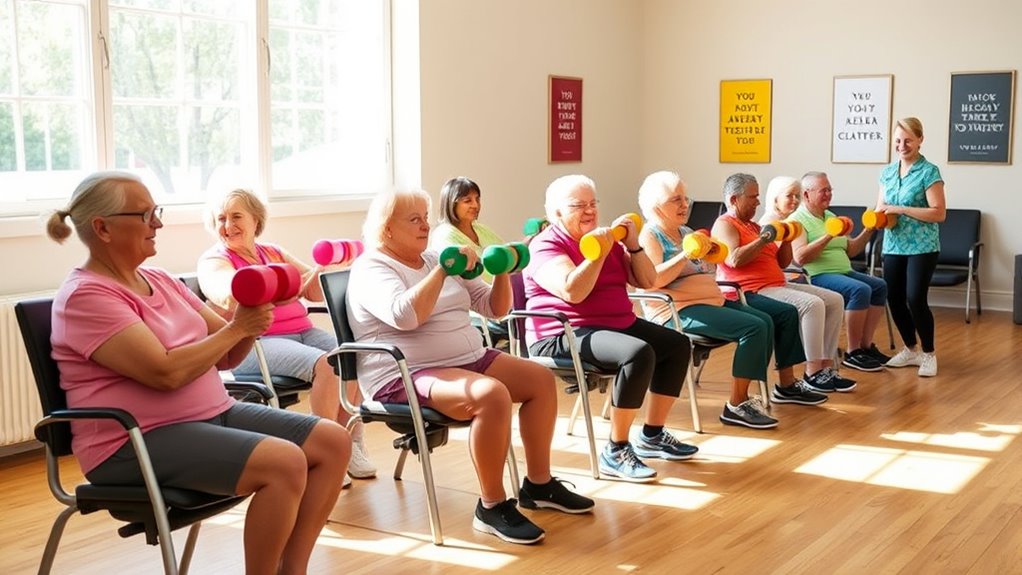
Staying motivated in your fitness journey can feel challenging at times, especially as you face the natural ups and downs of life.
To keep your spirits high and your back straight during seated strength training, consider these tips:
- Set achievable fitness goals to maintain focus and direction.
- Track your progress with a journal or app to visualize improvements.
- Join a group or find a workout buddy for accountability and companionship.
- Incorporate variety into your routines to keep workouts exciting and engaging.
- Celebrate small milestones, like completing a workout or increasing weights, to build confidence.
Incorporating Weights and Resistance for Better Results
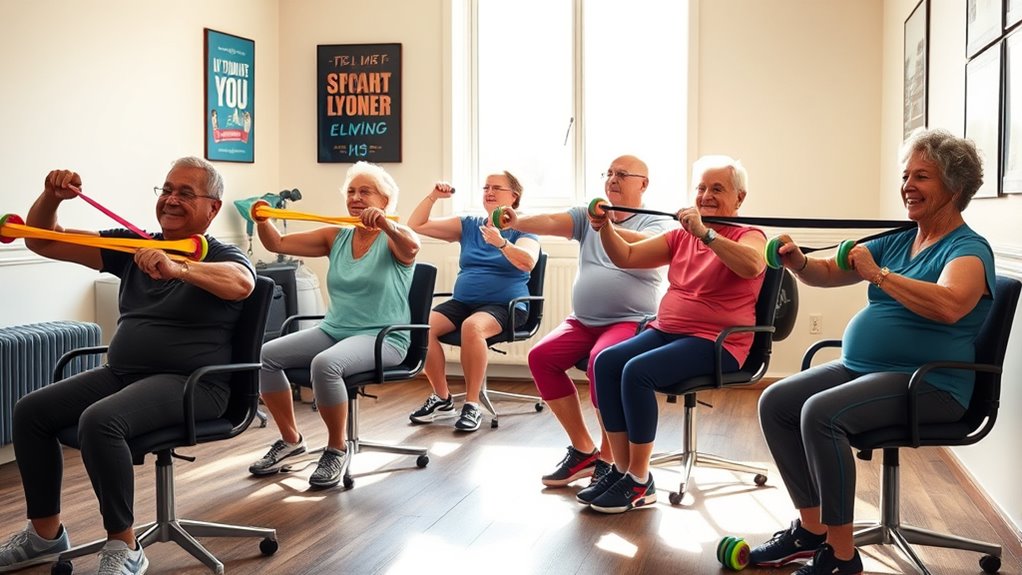
Incorporating weights and resistance into your seated strength training can greatly boost your results and overall fitness. Using items like water bottles or cans can profoundly enhance muscle engagement, promoting better strength gains.
Resistance bands are another great option; they offer adjustable tension, allowing you to safely increase workout intensity over time. Research shows that even light weights combat age-related muscle loss, making it essential for you to include resistance in your routine.
Cool Down Techniques to Aid Recovery
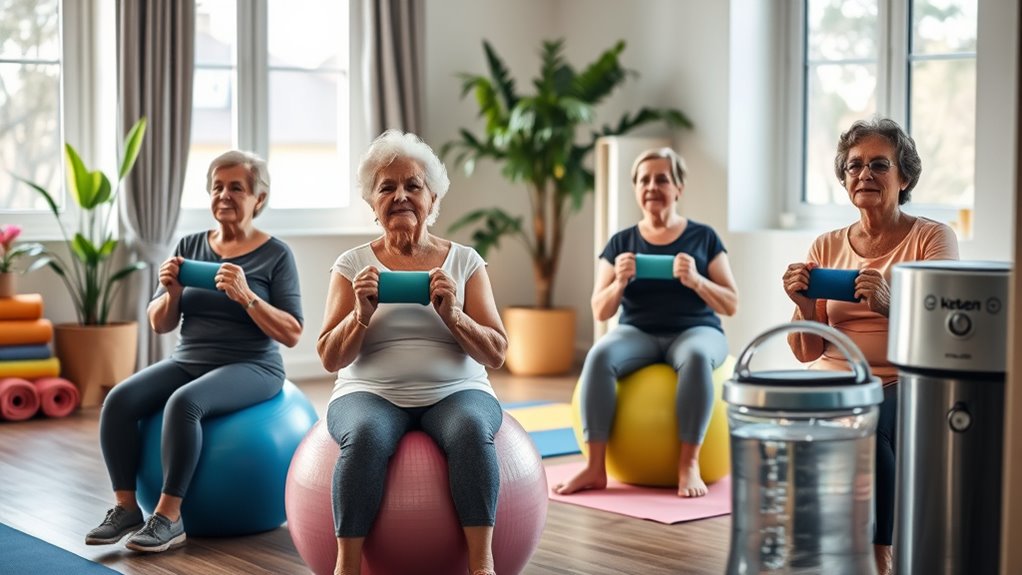
As you wrap up your seated strength training, focusing on cool down techniques can greatly aid your recovery.
Cooling down is essential to prevent injury and promote muscle recovery, allowing your body to shift from active to resting.
Cooling down is crucial for injury prevention and muscle recovery, helping your body transition from active to restful states.
Here are some effective cool down techniques to incorporate:
- Gentle stretches targeting major muscle groups to enhance flexibility
- Deep breathing exercises to lower your heart rate and promote relaxation
- Light movements like toe taps or arm circles to keep blood circulating
- Gradual shifts from intense activity to a seated position
- Hydration to replenish fluids lost during exercise
Frequently Asked Questions
Can You Build Muscle While Sitting?
Yes, you can definitely build muscle while sitting! Seated exercises like bicep curls or overhead presses effectively target your muscles without needing to stand.
Even if you have limited mobility, these workouts can help you strengthen your body safely. By incorporating resistance, such as weights or water bottles, you’ll enhance your muscle strength and endurance.
Consistent seated training can also improve your overall health and daily functional abilities. So, give it a try!
Do Seated Exercisers Work for Seniors?
Yes, seated exercisers definitely work for seniors! They offer a safe and effective way to engage in strength training, especially if you have mobility issues or balance concerns.
By incorporating resistance bands or light weights, you can effectively target major muscle groups while sitting down. This approach not only builds muscle mass but also improves overall strength, making daily activities much easier and reducing the risk of falls.
Do Chair Workouts Really Work for Seniors?
Yes, chair workouts really work for seniors. They provide a safe way to build strength and muscle without the risk of falling.
By incorporating exercises like seated bicep curls and leg lifts, you can effectively target both upper and lower body muscles. This routine not only enhances muscle mass but also improves bone density and daily functional capacity.
How Many Times a Week Should a 70 Year Old Lift Weights?
You might’ve heard that lifting weights can work wonders, and it’s true!
If you’re 70 or older, aim to lift weights at least two days a week. This helps maintain and build muscle mass, keeping you strong and active.
Focus on 1 to 3 sets of 8 to 12 repetitions per exercise. Consistency is essential, so make it part of your routine, and always check with a healthcare professional before starting.
Conclusion
Incorporating seated strength training into your routine can transform your fitness journey. By building muscle, enhancing strength, and improving posture, you’re not just staying active but thriving. Remember to warm up, challenge yourself with weights, and cool down for recovery. Celebrate your progress, stay motivated, and enjoy the process. Embrace the journey, empower your body, and enrich your life—seated strength training is your path to a stronger, healthier you!
